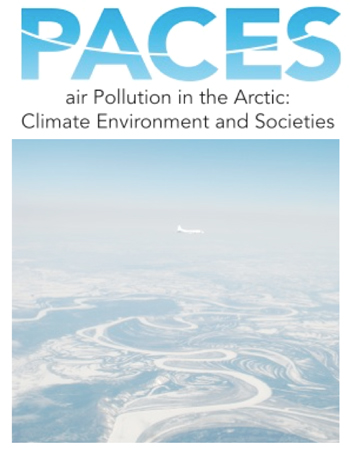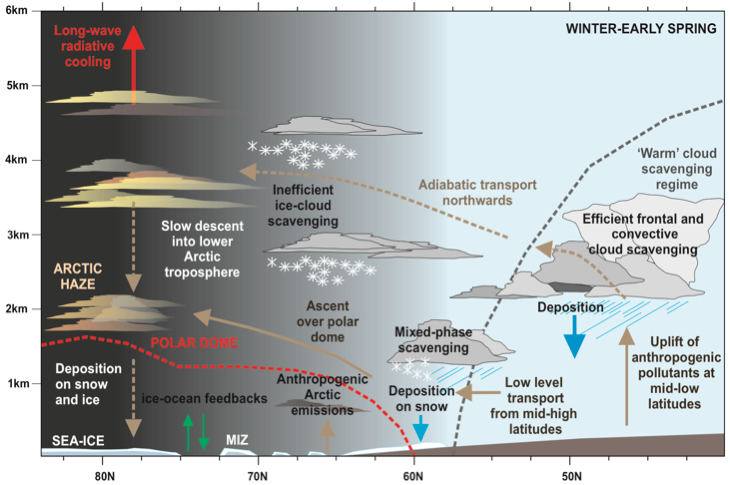A .gov website belongs to an official government organization in the United States.
A lock () or https:// means you've safely connected to the .gov website. Share sensitive information only on official, secure websites.
20 May 2016

When it comes to environmental change, the Arctic is on the fast track. Images of receding sea ice signal the change and have reached the public consciousness. The Arctic may well be the most sensitive region on the planet, and for that reason it is often called the "sentinel" of global change. Among the pressures on the Arctic is air pollution, coming from sources both outside and within the region. A paper published in the online journal Elementa: Science of the Anthropocene and coauthored by scientists in NOAA and CIRES describes a new international initiative to motivate and coordinate interdisciplinary work on the topic: PACES (air Pollution in the Arctic: Climate, Environment and Societies). The ultimate aim of PACES is to guide new research that will improve the ability to answer key questions: What are the sources and impacts of Arctic air pollution, and what does this mean for the Arctic?
Charles Brock (with the Chemical Sciences Division of NOAA's Earth System Research Laboratory in Boulder, Colorado) and Megan Melamed (with the Cooperative Institute for Research in Environmental Sciences, a cooperative institute of NOAA and the University of Colorado Boulder) are coauthors on the new paper, which describes the major science issues associated with Arctic air pollution and argues that the trans-disciplinary approach of PACES will be needed to address the complexities of this topic. The authors describe how environmental and societal issues are intertwined, for example with economic responses to warming (such as increased shipping when new water routes open up) leading to further warming. Hence the PACES initiative will involve collaborative efforts between Earth system scientists (atmosphere, ocean, cryosphere, and land surface), social science researchers, and local Arctic communities. The new initiative is being launched within the framework of the International Global Atmospheric Chemistry (IGAC) project and will span the next decade (2016-2026).
"PACES will take research on the Arctic atmosphere to the next level by coordinating and expanding efforts in measurement and modeling, and by broadening the perspective to include researchers in the social sciences," said Brock, an atmospheric chemist at NOAA ESRL CSD. "The PACES initiative acknowledges that the future of the Arctic is driven by multiple forces in both the environment and in society."

For atmospheric scientists, PACES will entail coordinated international field missions to gather atmospheric measurements (chemistry and meteorology) in more detail and over more extended periods of time than existing data sets. Instruments at ground stations, on aircraft, and on satellites will be part of the array that probes the Arctic atmosphere. The remoteness of the Arctic has always posed measurement challenges. But now, new technologies for accessing the remote atmosphere, such as drones, and innovative new instruments that are smaller and more sensitive, will combine to open up these new measurement opportunities in Arctic atmospheric science. The enhanced research activities and observations of PACES will also foster the advancement of models to reflect the complexity of the Arctic, and also will capitalize on the recent development of Earth System Models that include interactions between the physical climate system and ecosystems. Some of the key science topics to be addressed are:
The recommended efforts of PACES will build on, and link to, existing programs, networks, and initiatives in different regions of the Arctic. Activities in 2016 will include discussions among scientists to coordinate activities and with funders to plan future research efforts.
S. R. Arnold, K. S. Law, C. A. Brock, J. L. Thomas, S. M. Starkweather, K. von Salzen, A. Stohl, S. Sharma, M. T. Lund, M. G. Flanner, T. Petaäjä, H. Tanimoto, J. Gamble, J. E. Dibb, M. Melamed, N. Johnson, M. Fidel, V.-P. Tynkkynen, A. Baklanov, S. Eckhardt, S.A. Monks, J. Browse, H. Bozem, Arctic air pollution: Challenges and opportunities for the next decade, Elementa: Science of the Anthropocene, doi:10.12952/journal.elementa.000104, 2016.
The Arctic is a sentinel of global change. This highly sensitive region is in delicate balance and influenced by multiple physical and socio-economic drivers and feedbacks impacting both the natural and human environment. Air pollution is one such driver that impacts Arctic climate change, ecosystems and health but significant uncertainties still surround quantification of these effects. It includes harmful trace gases (e.g. tropospheric ozone) and particles (e.g. black carbon, sulphate) and toxic substances (e.g. polycyclic aromatic hydrocarbons, or PAHs) that can be transported to the Arctic from emission sources located far outside the region, or emitted within the Arctic from activities including shipping, power production, and other industrial activities. This paper summarizes the complex science issues motivating the creation of a new international initiative, PACES (air Pollution in the Arctic: Climate, Environment and Societies). Approaches for coor dinated, international and interdisciplinary research on this topic are described with the goal to improve predictive capability via new understanding about sources, processes, feedbacks and impacts of Arctic air pollution. Overarching research actions are recommended that include the development of trans-disciplinary approaches combining social and economic research with investigation of the chemical and physical aspects of Arctic air pollution; increasing the quality and quantity of observations in the Arctic using long-term monitoring and intensive field studies, both at the surface and throughout the troposphere and developing improved predictive capability across a range of spatial and temporal scales.